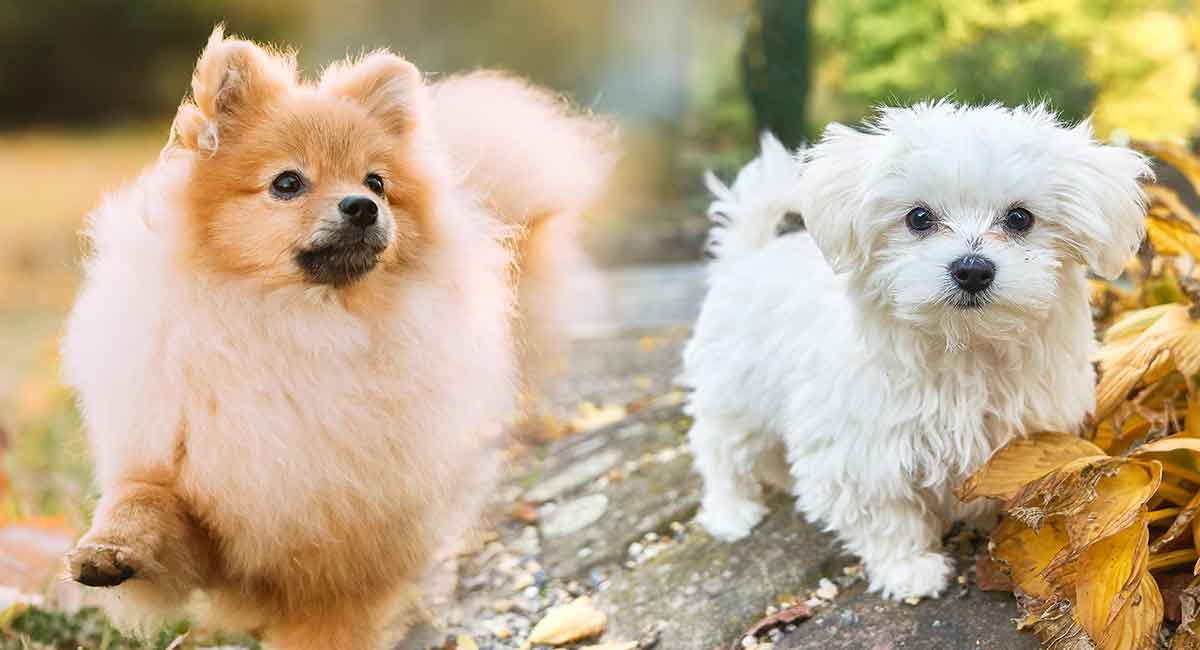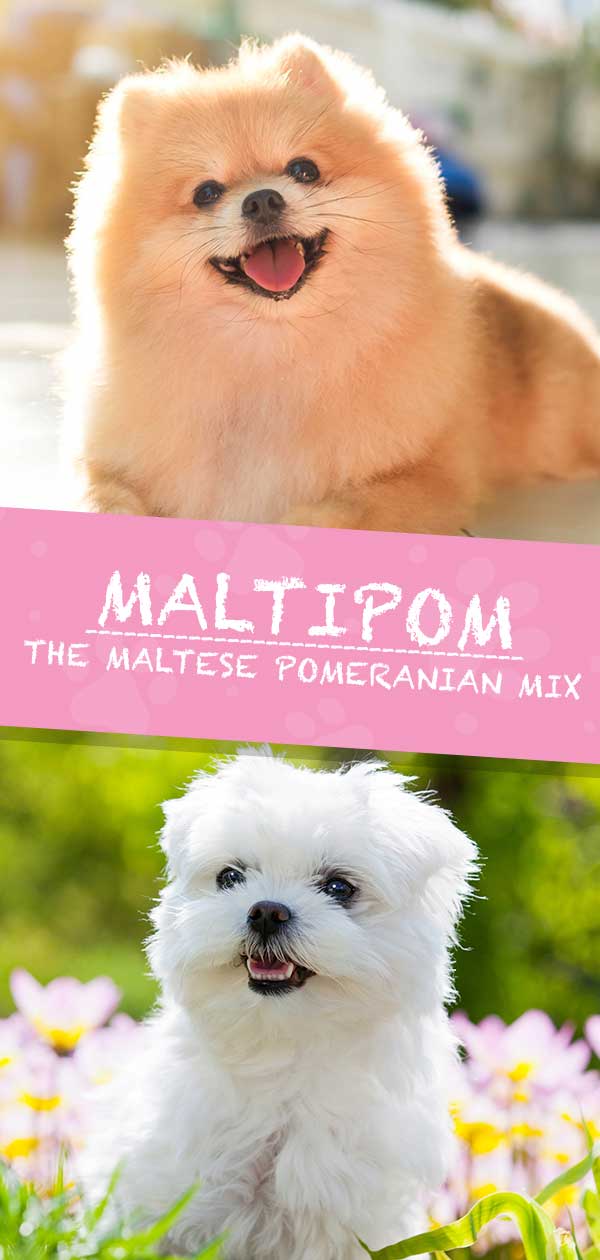
The Maltipom is a Maltese Pomeranian mix breed dog. Your Maltipom is likely to have a purebred Maltese parent and a purebred Pomeranian parent. But either parent dog could be second or even third generation, meaning that one or both of the dogs were Maltipoms themselves. Your Maltipom will weigh 3-7lbs and stand 6-9 inches tall when they are adult. And have a fluffy coat in diverse colors.
Contents
- What do Maltipoms look like?
- Coats, colors and grooming
- Temperament and personality
- Training, exercise and health
- Maltipom puppies
The Maltipom is affectionate, loyal, intelligent, trainable and active too. Maltipoms are friendly with kids but their tiny size does mean that they are quite fragile. This is an energetic, smart dog with lots of personality that loves to snuggle and play.
Regal Histories
The Maltipom is still considered a first-generation crossbreed, meaning they are new to the canine scene and therefore very little documentation exists about their origin. However, we can learn more about them by checking out the backstories of their purebred parents.
Maltese pups were a fashion statement for noble Roman women. They soon made regular appearances in Roman myths and fables, as a representation of devotion and loyalty. An archaeological research team found that the Romans loved their Maltese pups so much they even cared for them when sick, treating their arthritis and other age-related conditions.
Pomeranians were one of the favorite breeds among the British royals in the nineteenth century. The Queen brought some pups back after a visit to Italy and she quickly became an avid breeder!

Maltipom Appearance
Because this is a crossbreed, every puppy could inherit a number of physical characteristics from either of their purebred parents. The coat of the Maltese, for example, is long and silky, and always white. If left to grow to its natural length, a Maltese’s coat can grow all the way to the floor!
They have no undercoat and therefore their fur more like hair and will have some variation of between curly or wavy. The Maltese also have long ears and a long tail, a proportionate body, and bright, dark eyes. These pups tend to shed a bit less than other dogs, while Pomeranians are prone to the usual shedding.
On the other hand, Pomeranians have a fox-like face and pointed ears with round, black eyes and a lot of furs starting from their upper neck down. The Pom has a double coat—the undercoat is short and dense and the outer coat is very long and very thick! And they have an abundantly plumed tail, which is perhaps one of their most notable features.
When it comes to this Maltese Pomeranian mix, your pup could end up with any combination of the above characteristics. In general, though, they will have medium to long hair, and keep a fluffy appearance throughout their lives.

Maltipom Grooming
In general, your Maltese Pomeranian mix will need consistent care for them to feel and look their best. This crossbreed is prone to dental issues, just like its parents and other toy-sized dogs. Because of it, it’s important you schedule teeth brushing as part of their regular routine.
Regardless of the type of coat your pup has inherited, grooming should be an important part of your new routine. Because both the Maltese and Pomeranian need a bit of extra grooming, your mixed pup will require daily brushing to keep their silky coat free of knots.
How Big are Maltipoms?
When dealing with a purebred puppy, it’s pretty easy to estimate their adult size, height, and weight. All you have to do is look at their parents! However, with a crossbreed like the Maltipom, pinpointing exact size, height and weight outcomes are a bit more complicated.
This is because a crossbreed can inherit any number of characteristics from their purebred parents—it’s all left up to genetics. Still, since the Maltese and the Pomeranian are both toy dogs, we can estimate that the fully-grown Maltipom is going to be pretty tiny. But what is the full range of his height and weight? The easiest way to gage this is by looking at his purebred parents.
The Maltese, for example, stands at a mere 7 to 9 inches tall and weighs under 7 lbs. The Pomeranian, on the other hand, can be even smaller! They only grow to be around 6 to 7 inches tall and weigh between 3 to 7 lbs Prepare for your adult Maltese Pomeranian mix to be in the range of 6 to 9 inches and weigh around 3 to 7 lbs at most.
Temperament Traits
The Maltese are known for their gentle nature and spirited disposition. They are also affectionate and very adaptable to all types of situations and styles of home. In addition, they’re wonderful with children of all ages and other household pets, making for a great family dog or singles companion.
Quite the athlete, your Maltese will love snuggling up on your lap just as much as they will love running, playing, and showing off!
The Pomeranian is a bit livelier than the Maltese and can be vocal at times, unafraid to use their voice when they deem something to be out of place or suspicious! Because of this, excessive barking can be an issue when not properly trained.
They have a bit of a Napoleon complex and may be completely unaware of how small they are. This could end up being dangerous if you’re around strange dogs since your tiny pup may be unafraid to pick fights with almost anyone.
Are They Good With Kids?
Maltipom puppies are cuddly lap dogs that do great with children of all ages. They also get along with other house pets, love to play and run around the home.
By nature, these pups will be great family companions, however their bodies are small and fragile. Gentle handling and supervision are essential.
Maltipom Training and Exercise
The Maltese and Pomeranian are both active breeds, but they are also quite small. This means that a daily walk or play in the yard should be enough to meet your pup’s exercise needs. Also, both of the Maltipom’s purebred parents are intelligent dogs, so training your Maltipom should be fun and fairly straightforward.
Of course, as with all pups, it’s important to train through positive reinforcement and keep a consistent schedule. Early socialization and obedience training will be key to ensure your pup feels confident in all situations and behaves accordingly.
In the case of Maltipom puppies, it will also help with any excessive barking that might come up.
Training your pup is only part of their care. As a responsible owner, you need to groom your furry friend to make sure they stay healthy and happy.
Maltese and Pomeranian Health
Your Maltipom is a crossbreed, so similar to temperament and physical characteristics, they may also inherit health issues from either parent.
The Maltese has a lifespan of 12 to 15 years, and although described as a hardy dog, they are still prone to a number of issues. Among them, we can count inherited deafness, hypoglycemia, tracheal collapse, pyloric stenosis, dental issues and liver shunt.
On the other hand, the Pomeranian, with a lifespan of 12 to 16 years, is prone to obesity, dental issues, distichiasis, entropion, hypoglycemia, patellar luxation, tracheal collapse, severe hair loss syndrome and hypothyroidism.
Since there is no way to tell by looking at a Maltipom puppy what they may have inherited from their purebred parents, we recommend early health screening. Talking to your chosen breeder and knowing the possible conditions your pup might have will help you avoid or prepare for any future health issues in your Maltipom dog.
Maltipom Puppies
If you think the Maltipom is the right dog for you, it’s important to go through a reputable source when looking for the right puppy.
Pet stores and puppy mills might seem like a good option, but it’s important to understand these sources don’t have the pups best interest in mind. These establishments indiscriminately breed dogs without regard to the health and wellbeing of neither parents nor pups.
You will be paying an affordable price, but you’ll never be sure what diseases your pup might have, or the temper of either parent. Instead, when choosing a breeder you’ll know exactly what you’ll get. You’ll get to know the parents, their tempers and appearance, so you can have a better idea of what your puppy will be like.
A breeder will also do proper genetic testing and health screening of both parents to make sure that no diseases are passed on. Especially because crossbreeds have gained popularity and these dogs don’t have a standard, it’s key you source your puppy from a trustworthy person.
What About Adoption?
While shelters and rescues are always a great option, remember that finding a Maltipom may be hit or miss, depending on the time and place you are looking. You may be able to find other mixes, like the Pomeranian Maltese Poodle mix, for example, but finding a Maltese Pomeranian crossbreed will definitely be up to chance.
However, one of the best things about going through a rescue is that shelters will often cover the initial veterinarian fees. They can also offer first-hand advice on a dog’s personality because they’ve had the time to interact with them.

Thuy To says
My maltipom is 19 year old, has poor cision and deaf but seems to be in good health, still eat well.
Pamela says
I have a maltipom who is female and just six months she has bitten me twice quite badly the needed hospital treatment the first time she took my granddaughter sick and the little one won’t it back and when I tried to take it she bite my finger and the same the next time
Jack Davis says
We are interested in a female maltipom puppy